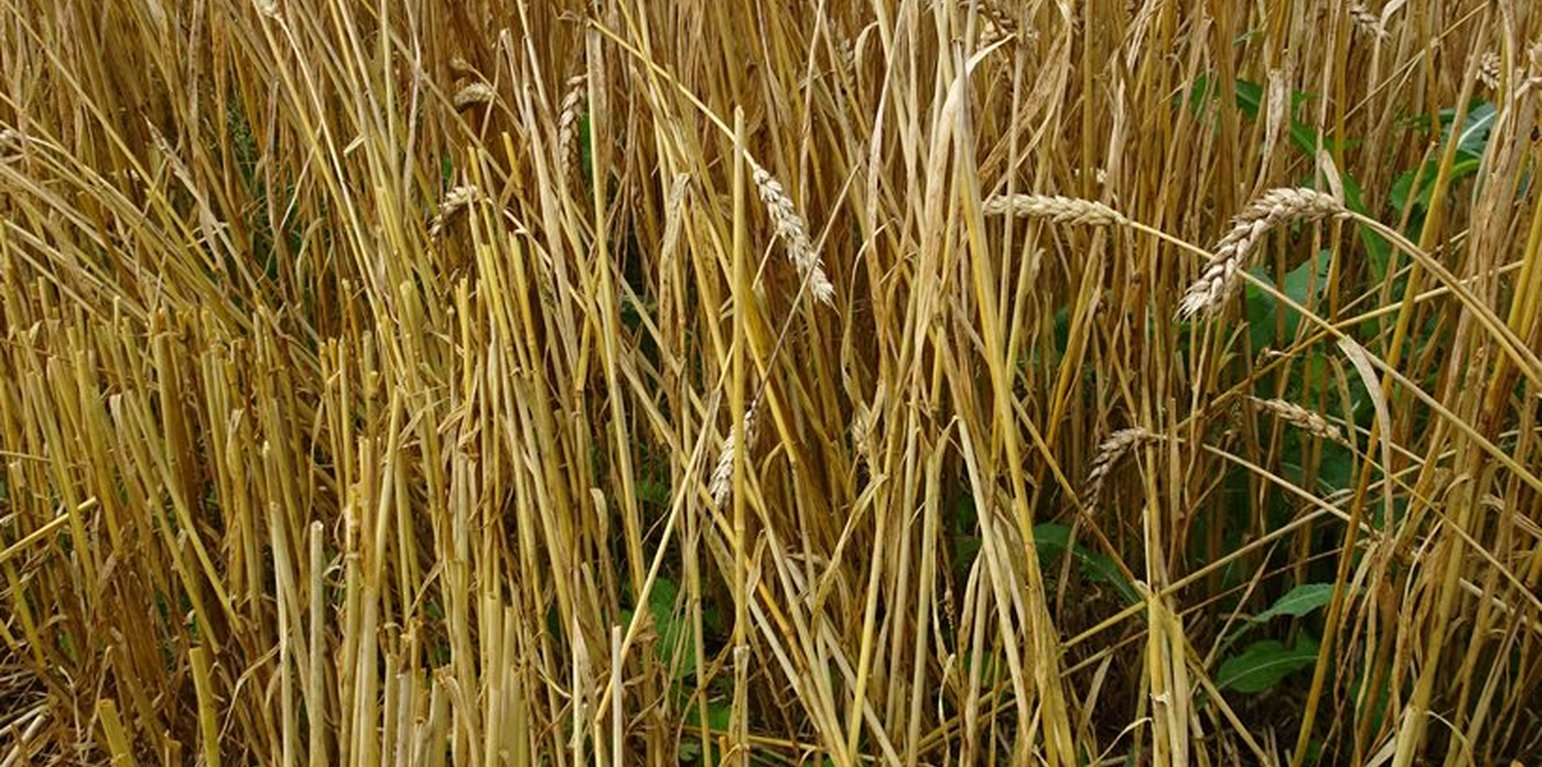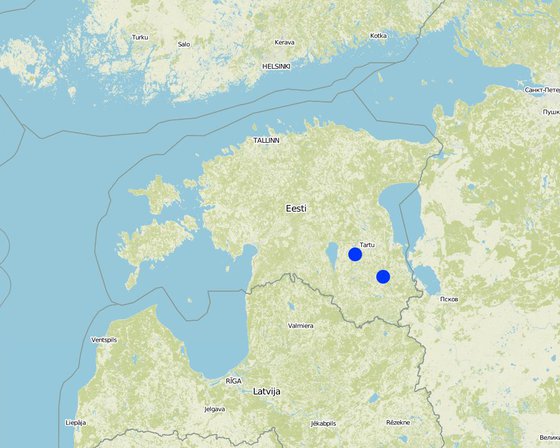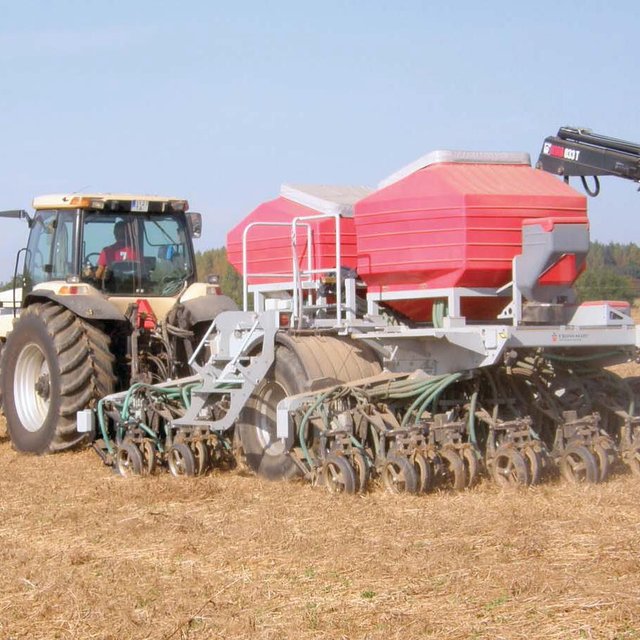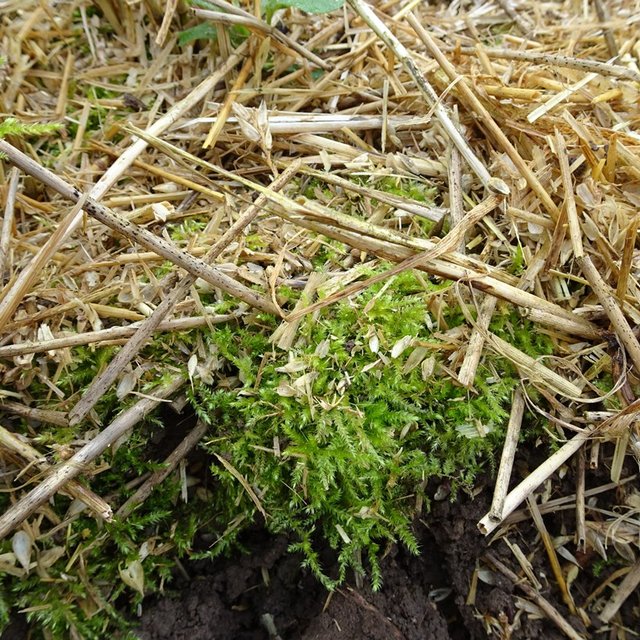



The technology is applied in sub-humid climate with an average of 696 mm of precipitations per year, from which more comes from July to October and less in March and April. Average annual temperature is +4 C, length of the growing period is 180-195 days. The territory is mostly flat, the southern part is hilly with slopes of 6-10%. Average altitude from the sea level is 50 m. About half of the Estonian territory is above 50 m and half is below it. Soils are from very shallow (less than 0.1 m) in the north to very deep (> 120m ) in the south. Soil cover is very variable. In the agricultural area the soils are medium textured with low (< 1%) to high (>5%) organic matter in topsoil. Groundwater is near the surface in wet soils and deep in hilly areas. Biodiversity varies from high to low depending on soil and landscape. Market orientation of production system is mixed and off-farm income is less than 10%. Relative level of wealth is average from individual households to cooperatives. Soil management is mechanized. Land belongs to land users, but is leased also in case of bigger farms (over 100 ha).
The purpose of the technology is to reduce soil disturbance and with that to reduce erosion and leaching, increase carbon storage, water infiltration and biological activity. Only 5-10% of the soil surface is disturbed during sowing. The drilling is made by special machinery and thus no-till farming requires specialized seeding equipment designed to plant seeds into undisturbed crop residues and soil. Drilling depth depends on the specific needs of the culture. If the straw remains on the field, it should be chopped to smaller pieces (25-40 mm). For direct seeding it is good if the previous culture was seeded with wider spacing, for example 25 cm and harvest height is 15-20 cm. New sowing will be done between previous crop rows. The highest investment to this technology is the new drilling machine. At the same time there is no need for special tillage machines. In order to help eliminate weed, pest and disease problems, crop rotations and pesticides are used. The system is not suitable for root crops. The no-till system is suitable for cereal based cropping systems as well as for renewing grasslands. The suitable crop rotation, for exampe, is: winter oilseed rape - winter wheat - pea (or bean) - winter wheat - spring barley undersown with red clover - red clover. The main benefit is the reduced working time, fuel costs and with that the lower net-cost of the product, but also the better soil structure. The adoption of the technology may increase weediness and pests and decrease the yield due to the preliminar soil compaction of upper 10-20 cm soil layer. If the soil surface of the field is not enough levelled out, the uniformity of the depth of the seedlings can suffer. There is also increased use of pesticides to control weeds, pests and diseases compared to minimum and conventional tillage. The technology is most suitable for medium-texture soils.

Местоположение: Tartu county, Meeri; Põlva county, Puuri, Tartu county, Põlva county, Эстония
Число исследованных участков, где применяется Технология: 2-10 участков
Пространственное распространение Технологии: равномерно-однородное применение на определенной площади (approx. 1-10 км2)
На постоянно охраняемой территории?:
Продолжительность применения Технологии: менее 10 лет назад (недавняя)
Тип внедрения/ применения








| Опишите затраты | Единица | Количество | Затраты на единицу (EUR) | Общая стоимость на единицу (EUR) | % затрат, оплаченных землепользователями |
| Оборудование | |||||
| Direct seeder (3m) | piece | 1,0 | 25000,0 | 25000,0 | 100,0 |
| Общая стоимость запуска Технологии | 25'000.0 | ||||
| Общие затраты на создание Технологии в долларах США | 21'186.44 | ||||
| Опишите затраты | Единица | Количество | Затраты на единицу (EUR) | Общая стоимость на единицу (EUR) | % затрат, оплаченных землепользователями |
| Оборудование | |||||
| Sowing with fertilization | times | 1,0 | 55,9 | 55,9 | 100,0 |
| Plant protection | times | 4,0 | 11,2 | 44,8 | 100,0 |
| Fertilization during growth period | times | 1,0 | 16,2 | 16,2 | 100,0 |
| Harvest and grain transport | times | 1,0 | 118,4 | 118,4 | 100,0 |
| Drying and after harvest activities | times | 1,0 | 132,1 | 132,1 | 100,0 |
| Посадочный материал | |||||
| seeds | kg | 200,0 | 0,28 | 56,0 | 100,0 |
| Удобрения и ядохимикаты | |||||
| Ammonium nitrate (2x per season) | kg | 147,0 | 0,84 | 123,48 | 100,0 |
| Complex fertilizer (27 kg N, 40 kg P and 112 kg K per ha) (450 kg of fertilizer per ha) | kg | 179,0 | 0,74 | 132,46 | 100,0 |
| Herbicides (2 times) | times | 2,0 | 27,0 | 54,0 | 100,0 |
| Fungicides (1 time) | times | 1,0 | 33,2 | 33,2 | 100,0 |
| Insecticides (1 time) | times | 1,0 | 3,6 | 3,6 | 100,0 |
| Retartants | times | 1,0 | 14,0 | 14,0 | 100,0 |
| Общая стоимость поддержания Технологии | 784.14 | ||||
| Общие затраты на поддержание Технологии в долларах США | 664.53 | ||||
In different years the crop production may be higher than by ploughing, but another year lower. There has been decrease of spring barley yield by 0.1 t/ha. Winter wheat yield has been ca 1.4 t/ha higher than by ploughing.
No statistically significant difference has been found. However, winter wheat 1000 grain weight was reported 39.6 g by no-tillage and 38.5 g by ploughing.
No need for soil tillage. Instead of several machinery to till the soil, one compact sowing machine is needed.
Less cost for fuel because 50% less fuel is needed compared with ploughing.
Even if the yield is a little bit lower or the same as with ploughing, the unit cost to produce barley or winter wheat is 8-11 EUR less than with ploughing.
No time to be spent for tillage. Even extra spreading of pesticides takes less time than ploughing and other tillage operations.
Unit cost of the production is lower and thus it is possible to sell production cheaper.
If land was eroded before and soil was on the road, everybody can see the differences after establishment of the grasslands. It is not so severe in case of peatlands, however, less tractors will stuck in to the mud on rainy period.
Residues remaining on the soil surface help to catch more snow during the winter.
Plant residues protect soil surface structure from raindrop effects, allowing water to infiltrate quicker in the soil.
Undisturbed soil pore structure allows water quicker to drain in the deeper soil layers. Water permeability of long-term no-till soil is 2 times higher than under conventional management.
Residues on the soil surface do not allow quick evaporation, protecting soil surface.
Soil moisture content was 3% higher than by ploughing, but not significantly.
Количество до применения УЗП : 0
Количество после применения УЗП: 100%
The soil is covered by plants or by plant residues during the whole year.
Residues and plant cover stop both wind and water erosion.
Reduced decomposition of organic matter increases organic carbon content by 0.1-0.2%.
No crust after applying no-tillage as plant residues protect the soil surface.
Increased from the top (by 0.04 g/cm3) but decreased deeper in the soil by 0.08 g/cm3) compared to the ploughing. No plough pan. Soil penetration resistance was 1 MPa lower between 20-40 cm under no-tillage compared to ploughing.
Due to the decreased decomposition of organic matter and the increase of organic carbon, more nitrogen remains in the soil.
It was found that there was slight increase of organic carbon (Corg) by 0.1-0.2% in upper 5 cm of soil compared to ploughing.
Plant/residue cover is during the whole year.
As there is no tillage, all residues remain on the soil surface.
Due to the need of changes in crop rotation, more diverse rotations instead of monoculture to suppress weeds. Weeds diversity might increase and change due to the reduced tillage intensity.
More spiders, beetles, ants compared with ploughing.
Количество до применения УЗП : 2 species of earthworms
Количество после применения УЗП: 3-4 species of earthworms
More earthworm species and higher abundance compared with ploughing.
No-till areas create different pattern to the landscape.
Some diseases and pests are surpressed, but there is increase of slugs and snails.
Due to the reduced use of fuels for tillage, less greenhouse gases will be released. 0.05 kg/ha less greenhouse gases per kg yield is reported by no-tillage compared to ploughing.
Dry plant residues are a high risk in spring.
Due to the residue cover the soil temperature and water content fluctuations are smaller.
Due to the higher amount of organic matter, the nutrients and water holding capacity is higher.
No wind erosion after applying no-tillage.
No sediments from the field to the neighbours fields.
In case of erosion, no soil is carried by water or wind to the ditches and on the roads.
Due to the reduced use of fuels for tillage, less greenhouse gases will be released. 0.05 kg/ha less greenhouse gases per kg yield is reported by no-tillage compared to ploughing.